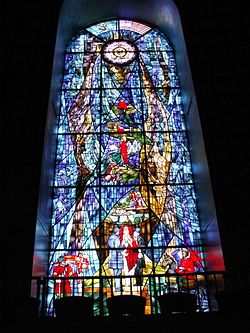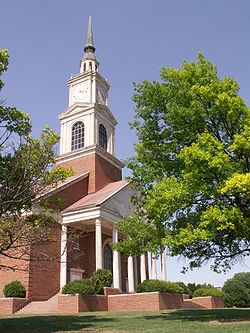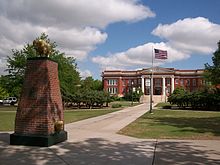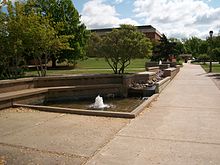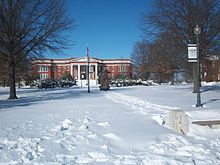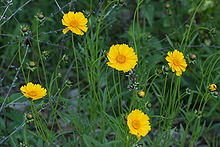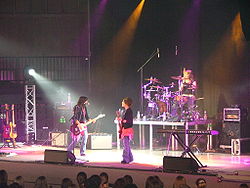- Oklahoma Baptist University
-
Oklahoma Baptist University Motto "Eruditione Religioneque Veritas" Established 1910 Type Private Endowment $93.7 million President David Wesley Whitlock Academic staff 113 Students 1,871 (Fall 2011) Location Shawnee, Oklahoma, United States Campus Urban, 200 acres Colors Green & gold
Mascot Bison Affiliations Baptist General Convention of Oklahoma, Southern Baptist Convention Website www.okbu.edu Oklahoma Baptist University (OBU) is a co-educational Christian liberal arts university located in Shawnee, Oklahoma, and owned by the Baptist General Convention of Oklahoma. Established in 1910, OBU is ranked No.2 among baccalaureate colleges in the western region in the 2010 U.S. News & World Report “America’s Best Colleges” ratings and has been Oklahoma’s highest rated regional college in the U.S. News rankings for 16 consecutive years.[1] According to The Princeton Review, OBU is a 2010 “Best in the West” institution and one of "America's Best Value Colleges."[2] OBU was named Oklahoma's top-ranked university in the Forbes.com 2010 listing of "America's Best Colleges" and was the state's top college in the Forbes.com list of "America's Best College Buys."[3]
Contents
History
A commission to plan the founding of a Baptist university in Oklahoma was established by the Baptist Convention in 1906 (one year prior to Oklahoma statehood) while in session in Shawnee. At the second annual meeting of the Baptist General Convention of Oklahoma (BGCO) at Ardmore in November 1907, the Baptist Education Commission unanimously passed a resolution stating its sense that "as soon as practicable a new Baptist University be established.” A board of trustees was elected soon thereafter in 1907. A site for the university was sought, and from 1908–1909 negotiations were held with entities in El Reno, Lawton, Chickasha and Oklahoma City without reaching agreeable terms.
At the 1910 annual meeting of the BGCO in Enid, the trustees reported that Shawnee had been selected as the site of the new university and that an incorporation certificate for "the Baptist University of Oklahoma" had been issued by the State of Oklahoma on February 9, 1910. Plans for the administration building had been drawn and a contract for construction of the building had been signed on June 3, 1910. The total estimated cost to construct, equip, and furnish the building was $140,000. The trustees reported that the City of Shawnee “through its development company, gave to the denomination sixty acres of land worth $1,000 per acre and a cash bonus of $100,000.” Dr. J.M. Carroll, San Marcos, Texas, was selected as the school's first president and construction on an administration building commenced in February 1911.
The university opened in September 1911, holding classes for 150 students in the basement of the First Baptist Church and in the Convention Hall of Shawnee. Students came from other universities and preparatory schools, and at the close of the 1911–12 school year nine students received degrees. Included in the first student body were three men who later served as United States Senators: Josh Lee and Robert S. Kerr of Oklahoma and Huey P. Long of Louisiana.
A general depression in the State in 1911 however had a negative effect on the finances of the BGCO, as well as the development company that had promised the $100,000 cash bonus, which it was unable to deliver, and construction on the Administration Building was halted. After the completion of the first school year in 1912 Dr. Carroll resigned and recommended that operations of the school be temporarily suspended. His recommendation was adopted and the university was placed in a period of "suspended animation" while further organization and fund-raising progressed. The report submitted by the Board of Trustees to the BGCO annual meeting in 1914 discussed the need for completion of the construction of the administration building and recommended the convention "begin at once to provide for the equipment of the building and make other necessary provisions for the opening of school in September, 1915." Frank M. Masters, pastor of the First Baptist Church of Ardmore and a member of the BGCO's Education Commission, was selected by the school's Board of Trustees as the president who would re-open the university. The Administration Hall (renamed Shawnee Hall in the 1920s) was finally completed in September 1915 in time for the re-opening.
The university reopened for the fall 1915 semester with a total enrollment of 143; with about a third of them ministerial students. OBU has been in continual operation in Shawnee since that time. The name of the university was officially changed to "The Oklahoma Baptist University" in 1920.
In 1915, Shawnee Hall housed faculty, staff, classrooms, library, an auditorium which doubled as a gymnasium, and the women's dormitory. Shawnee Hall did not house male students, as they were housed in two privately owned off-campus homes, known as "Hill Hall" (located half of a block south of the intersection of Kickapoo and MacArthur streets) and "Douglas Hall" (located on south University street where Bailey Business Center now stands). Shawnee Hall did not provide enough space for women's housing, therefore, in 1916 ground was broken on a new dormitory for women. The new residential unit was opened in 1917 and named Montgomery Hall, in honor of Dr. and Mrs. D.M. Montgomery, who provided significant financial support for the project. Montgomery Hall served as a dormitory, the fine arts center, the student center, and the location for administrative services. The original Montgomery Hall was located between Shawnee Hall and WMU Memorial Dormitory on the campus oval. The building was removed in 1989 due to structural concerns and a new Montgomery Hall was located on south University street west of the Bailey Business Center. In 1918, work began on a combination men's dormitory and gymnasium and the building was completed in 1919. Most of the dormitory was located on the east end of the building, now known as Owens Hall. The gymnasium was used until 1941 when a new gymnasium was opened. The old gymnasium was converted into the W.L. Brittain Learning Center in 1946, and in 1976, became a part of the Mabee Learning Center. From 1919 to 1928, campus facilities consisted of three buildings, Shawnee Hall, Montgomery Hall, and the combination men's dormitory and gymnasium. In the mid 1920's under the leadership of Berta K. Spooner; Executive Secretary-Treasurer of the Oklahoma Women's Missionary Union, Baptist women of Oklahoma recognized the need for a new dormitory for women on Oklahoma Baptist University's campus. After a fundraising effort to procure sufficient financial support for the new dormitory, groundbreaking occurred in 1927 for the new facility. When WMU Memorial Dormitory opened in 1928, the building housed rooms for 200 female students, the university dining hall, parlors, assembly rooms, a recreation room, an infirmary, and a swimming pool. Due to the challenges of "The Great Depression" in the late 1920s to the 1930s, it would be another decade before another building was constructed on campus.[4][5]
Oklahoma Baptist University served as an army aviation training site from February 1943 through the summer of 1944, hosting the 91st College Training Detachment. Cadets lived in WMU Dormitory, attended classes in Shawnee Hall, drilled on the campus oval, and exercised on the athletic fields. During the time of the U.S. Army attachment during World War II, approximately 2,000 cadets were trained during the sixteen months of OBU retaining military detachment. According to John Wesley Raley, OBU's president during that time, "OBU's participation in the military program provided several benefits: Satisfaction that the university had participated in the war effort; favorable advertising through the cadets who had been on campus; the ability to maintain a strong faculty, despite the decline in regular enrollment which had dropped to 326 in 1943, the smallest enrollment since 1918; the maintenance and enlargement of the physical plant; and operating without a deficit during a 'most difficult period for colleges'". Although the university participated in the war effort during World War II, the university does not have an active ROTC program at this present time.
In January 1964, during final examinations week, the school narrowly missed disaster when a man flew a small airplane into Shawnee Hall. The man had been hospitalized for mental health problems but had been released and was able to rent a plane in Tulsa. He radioed the Shawnee airport and reported that he was going to fly his plane into OBU's administration building. Authorities evacuated Thurmond Hall, which had been the university's administration building since 1954, and moved students to Shawnee Hall; the primary classroom building. Unfortunately, Shawnee Hall had been the administration building prior to 1954. The pilot then flew his plane into one of the few empty classrooms in the building and when the plane crashed into room 307, the students made a calm and orderly exit. The pilot was killed and the exterior impact area along with two classrooms were badly damaged. Miraculously, none of the 300 students, faculty, or other staff were injured. Today, Shawnee Hall bears the scars of this incident. Although all damage has been reparied, the brick and mortar on the south side of the building is discolored in one area on the third floor when Shawnee Hall is viewed from the campus oval.[6]
Total annual enrollment in the university exceeded 1,000 for the first time in 1946. OBU was officially racially integrated in 1955, when the Board of Trustees approved a motion by Dr. Herschel H. Hobbs, pastor of Oklahoma City's First Baptist Church, to allow African American students admission to the university. Enrollment passed 2,000 for the first time in 1989 and a record enrollment of 2,440, with 2,011 on campus, was set in 1994. In 1999, acquisition of land north of the campus enlarged OBU property from 125 to approximately 190 acres (0.77 km2). By 2005, the university's endowment exceeeded US$80 Million. In 2007, OBU's International Graduate School opened in Oklahoma City, offering a masters of business administration degree. Acquisition of 10 additional acres of land at the southwest edge of the campus in 2008 increased OBU's property to 200 acres (0.81 km2), and in 2010, the university celebrated its first Centennial.[7]
Academics
Undergraduate degrees
OBU offers programs in 84 areas of study in five academic schools, leading to the following undergraduate degrees : Associate of Arts in Christian Studies; Bachelor of Arts; Bachelor of Science; Bachelor of Science in Education; Bachelor of Business Administration; Bachelor of Music; Bachelor of Music Education; Bachelor of Fine Arts; Bachelor of Musical Arts; and Bachelor of Professional Accountancy. Minimum requirements for the baccalaureate degree are 128 semester hours of course work. All students complete a program of Common Core and Flex Core courses, and courses in an area of concentration, or major and minor courses, to bring the degree program to the minimum of 128 hours; some professional programs require more than this total number of hours. A minimum of 39 hours must be junior or senior level. In keeping with the school's liberal arts focus, the Common Core curriculum emphasizes diverse education, including history, literature, religion, science, mathematics, the social sciences, and the humanities. The Flex Core, which will vary in content according to the degree chosen, consists of a minimum of 12 hours chosen to strengthen the Common Core but also to provide flexibility to serve specific needs of the various degrees.
Graduate degrees
OBU offers two graduate degrees through the OBU Graduate School, based in downtown Oklahoma City. The school currently offers a MBA degree with an international business focus, and a Master of Science in Nursing degree. Both programs require applicants to possess an earned bachelors degree from an accredited college or university with a minimum GPA of 3.0.
Colleges and divisions
- College of Arts and Sciences: Division of Language & Literature, Division of Behavioral & Social Sciences, Division of Science & Mathematics, Division of Kinesiology & Leisure Studies, Division of Teacher Education
- Joe L. Ingram School of Christian Service
- Paul Dickinson School of Business
- School of Nursing
- Warren M. Angell College of Fine Arts: Division of Music, Division of Communication Arts, Division of Art
- OBU Graduate School
Faculty
For the 2009–2010 academic year, OBU employed 113 full-time faculty members. 71% of the faculty possessed the highest degree available in their field. No classes are taught by graduate assistants. The student to faculty ratio is 15:1.
Campus
Location
The OBU campus, referred to as "Bison Hill," contains over 30 buildings on 200 acres (0.81 km2) in north Shawnee, Oklahoma a city of about 28,000 residents, 35 miles (56 km) east of Oklahoma City. The campus is bordered by N. Kickapoo Street to the east, W. Midland Street to the south and N. Airport Drive to the west. W. McArthur Street runs through the north side of the campus, with the main campus lying south of the street and residential and athletic areas to the north.
Major buildings
Major campus buildings include the Art Building, Bailey Business Center, Ford Music Hall, Geiger Center, Jent Alumni Center, Mabee Learning Center (composed of a renovation of and an addition to the University’s former library building, W.L. Brittain Hall, and the faculty office building, Owens Hall), Montgomery Hall, the Noble Complex, John Wesley Raley Chapel, Andrew Potter Auditorium, Shawnee Hall (the original 1915 administration building), Stubblefield Chapel (erected in 1894 and moved to the campus in 1963), Sarkeys Telecommunication Center, Thurmond Hall and the W.P. Wood Science Building.
The university's primary library is located in the Mabee Learning Center (MLC). The collection of resources contains more than 184,724 bound volumes, 534,429 microform holdings and approximately 10,050 other media materials. The Learning Center also subscribes to several online indexes (Psyc. Info, MLA Bibliography, CINAHL, ATLA Religion Index, WorldCat, etc.) and full-text databases (EbscoHost, Academic Elite, Literature Resource Center, Biography Resource Center, InfoTrac Expanded Academic, NetLibrary, NewsBank, Electric Library, General Business File ASAP, Health Reference Center-Academic, etc.). It also subscribes to 450 print periodical/newspaper titles. The MLC is a United States government documents depository. Also located in the MLC is the Herschel Hobbs Baptist History and Heritage Center, containing the personal library, manuscripts, and memorabilia of Dr. and Mrs. Herschel Hobbs. Other archival collections include the B.B. McKinney music collection, the E.C. Routh Library of Missions, and the J.W. Storer collection related to the War Between the States and World War II.
The Andrew Potter Auditorium has a seating capacity of 2,000 and features the 56-rank Van Deren Memorial Organ. On the lower floor, the W.R. Yarborough Memorial Auditorium seats 400. The Mabee Fine Arts Center in Raley Chapel houses music classrooms, studios, rehearsal rooms, and the office of the Dean of the College of Fine Arts. Among the instruments in Raley Chapel is the McGavern Harpsichord, a two-manual French instrument constructed in 1974.
On August 1, 2011, a 6 foot tall bronze statue of Dr. James R. Scales was dedicated on the Oklahoma Baptist University campus in his honor. The statue features Dr. Scales dressed in university academic regalia and rests on a 4 foot tall brick podium, making the entire monument around 10 feet tall. The statue is located on the campus quadrangle, directly southwest of Shawnee Hall.[8]
Residential life
OBU requires all unmarried students under 21 years of age to reside in University housing. The University operates one residence hall (Agee Residence Center) and three apartment complexes (East Devereaux, McArthur West and Midland) for men, and two residence halls (Kerr and WMU Dormitories), two suite complexes (Taylor and Howard Residence Centers) and two apartment complexes (McArthur East and West University ) for women. Three apartment complexes are provided for married students (Burns, Cobbs and West Devereaux).
On-campus dining is provided in the Laura Scales Cafeteria, located in the upper level of the Geiger Center. Coffee and quick service dining is available at Java City and the Geiger Counter, located in the lower level of the Geiger Center. The Geiger Center also houses the mailroom, copy center, OBU Bookstore, meeting rooms, special dining areas and information desk, as well as a prayer room. The offices of the Dean of Students, Geiger Center Director, Director of Residential Life and Campus Activities, Student Government Association and the Student Services Center are located in the Geiger Center. The Student Services Center includes Career Planning Services, Testing Services, Special Services, Counseling Services, and Student Health Services.
Athletics
OBU athletic teams, nicknamed the Bison, compete in the Sooner Athletic Conference of the NAIA in 17 sports: baseball, men & women's basketball, men & women's cross country, men & women's golf, men & women's soccer, softball, men & women's tennis, men & women's track & field (indoor and outdoor), and women's volleyball. OBU has a total of eight NAIA National Championships: men’s basketball (1966 and 2010); men’s outdoor track and field, (1990 and 2007); women’s indoor track and field, (2005, 2007, 2010 and 2011).[9]
The Noble Complex, completed in the summer of 1982, is a 55,000-square-foot (5,100 m2) building which houses a 2,500-seat arena, a 25-meter indoor/outdoor swimming pool, four handball/racquetball courts, a human performance laboratory, an athletic heritage center, and classrooms and offices for health, physical education and recreation. Clark Craig Fieldhouse, a part of the complex, was built in 1948 and underwent renovation in 1982, and provides an indoor jogging track, indoor tennis courts, and facilities for a wide range of recreational activities and intramural events. The complex also includes a varsity baseball diamond, a varsity softball diamond, intramural playing fields for softball and soccer, and a 400-meter track and field facility, which has an all-weather surface.
The OBU Recreation and Wellness Center (RAWC, pronounced "rock") was completed in 2007 and includes cardio and weight machines, a 29-foot (8.8 m) rock climbing wall, an indoor running track, three basketball/volleyball courts, three racquetball courts, a swimming pool, and a snack bar/lounge. The RAWC is home to many campus intramural sports, which include Basketball, Bowling, Flag Football, Free Throw Shooting, Racquetball, Sand Volleyball, Softball, Tennis, Volleyball, and Ultimate Frisbee.[10] On December 16, 2010, Oklahoma Baptist University president, Dr. David Whitlock announced that football, lacrosse, and varsity swimming teams would be added to the list of athletics. Beginning with swimming and lacrosse in 2012, and football in the fall semester of 2013, the number of intercollegiate sports played at Oklahoma Baptist University is 21 sports, 10 men's teams and 11 women's teams. This marks the first time since 1940 that Oklahoma Baptist University fielded a football team.[11]
Rivalries
Oklahoma Baptist University has several rivals throughout the SAC. However, the university has a strong rivalry between St. Gregory's University which is about a mile west from Oklahoma Baptist University on MacArthur street in Shawnee. As a result of the religious affiliations of both universities (St. Gregory's being a Roman Catholic institution), some sports writers have referred to the althletic contests as "The Holy War on MacArthur street". Although considered to be more of a basketball rivalry, the rivalry has spilled into other sports such as baseball and soccer.[12][13]
Traditions
School Colors
OBU's school colors of green and gold were chosen by students in the first year of classes because the school's future campus of 60 acres (240,000 m2) of green prairie located northwest of downtown Shawnee was covered with wild golden coreopsis.[7]
Mascot
Before OBU was established, what is now known as "Bison Hill" was a buffalo wallow prior to the establishment of the university. OBU founders nominated the American Bison as a school mascot because they hoped that graduates would help meet the needs of the world as the bison met the many needs of the Native Americans. The Bison was selected as the school mascot in 1918, and "The Bison" student newspaper was first published in December of that year. The bison statue and pedestal on the Oval were donated by the Class of 1932. In 1962, a student organization, known as "The Sacred Order of the Bison", brought to the campus a live Bison mascot, which they named, "Belshazzar". Belshazzars I, II, III, and IV lived in a pen near the fieldhouse and athletic fields and members of "The Sacred Order of the Bison" were responsible for the care of the mascot. However, in 1974, due to concerns from "The Sacred Order of the Bison" and students alike, Belshazzar IV was released from the confines of the campus pen and allowed to roam on a semi-natural ranch near Bartlesville, Oklahoma. Since 1974, Oklahoma Baptist University has had no live animal mascot. The university does have a male and a female student dress in Bison mascot-animal costumes at some athletic and other special events.[14]
"Ka-rip!"
The "Ka-Rip" spirit chant was introduced by Fred McCaulley (Class of 1920) in 1918. It is repeated often and rapidly by OBU fans during sporting events, and memorization of "Ka-rip!" is an important part of OBU new student orientation. The chant in its entirety is:
Ka-rip Ka-rap Ka-riplo typlo tap
Oh! Oh! Rincto lincto hio-totimus
Hopula scipula copula gotimus
Chink-to-lack Chink-to-lee
Ka-willa, Ka-walla, Ka Victory
Oh! Oh! Hoogula choogula choogula can.
Ragula tagula melican man
Let'er go rip, let'er go ruse
Tingula Tangula, turn'em a-loose
Zip! Bang! OBU!
School Song
Hymn to Alma Mater became the official school song in 1939. Dean Warren M. Angell composed the music and Mary Ann Tisinger wrote the words:
OBU all hail thy name!
Sons and daughters honor thee;
May thy standard green and gold
Lead eternally.
Proudly stand on Bison Hill
‘Neath the wind-swept sky;
Alma Mater we will praise thee
As the years go by.
When the shades of evening fall,
Through the hush of fading day,
Silent voices praise thy name,
Hearts look up to pray.
May thy spirit guide thy sons,
Keep thy daughter true,
Loyal to our Alma Mater
God bless OBU.
Welcome Week, Beanies and The Walk
"Welcome Week" is OBU's program of orientation for all new students prior to the start of the fall semester. New students are given a green and gold beanie that is worn throughout welcome week, taught the Ka-rip! spirit chant and the school song, and introduced to college life. Students also engage in a "Serve Shawnee" service project. On the night before classes begin, new students participate in "The Walk" from the Oval to Raley Chapel, mirroring the walk taken on graduation day. Beanies and the traditions concerning them have varied over the years, but the tradition of recognizing and welcoming new students to campus has been revived yearly for over 90 years. The tradition began in the 1919–1920 school year when the incoming freshmen students were the first to wear the beanies and the beanies were worn for a full year as a sign of penance. By 1925, the OBU student handbook stated that freshmen were required to wear their "Greencaps" on campus from the beginning of Fall semester until Thanksgiving. In 1933, the student handbook said that freshmen were required to wear the "Greencaps" until the final home football game. At halftime of the final game, freshmen were permitted to burn their beanies. In 1968, freshmen were supposed to wear beanies between 7 o'clock a.m. and 11 o'clock p.m. while on campus during "Welcome Week". If the freshmen won the "Freshmen-Upperclassmen Tug-O-War", then they could dispose of their beanies. If they lost the contest, then they had to wear their beanies for another week.[15]
Hanging of the Green
The "Hanging of the Green" is an OBU Christmas tradition that dates back to 1937 and is held on the first Friday in December to commemorate the holiday season. The events include a formal dinner, a musical production featuring familiar religious and secular Christmas carols, a dramatic production, honoring of senior students, and the adornment of Raley Chapel with wreathes, Christmas trees, and other Christmas ornamentation. The program has been varied through many years, but has always included Christmas greenery and honoring senior students. The first "Hanging of the Green" ceremony was held in 1937 in WMU dormitory. During that ceremony, students sang Christmas carols and hung ornamental Christmas wreathes around the building. Afterwards, the students took a candle from that ceremony to each of their respective residence halls. In 1945, the ceremony was moved to the W.L. Brittain Library and Fine Arts Center (Presently, the Mabee Learning Center). In 1957, the ceremony was moved to the University Auditorium (Presently, Sarkey's Telecommunications Center). With the completion of Raley Chapel in 1961, the "Hanging of the Green" moved to Potter Auditorium. 2011 will mark the fiftieth consecutive "Hanging of the Green" held in Raley Chapel's Potter Auditorium. In addition to the "Hanging of the Green", various other buildings and trees are decorated before Christmas.[14]
Abandoned Traditions
Freshmen orientation and "Welcome Week" were once unofficially known as "Freshmen Initiation". Freshmen were required to wear a nametag and "Greencap", bow before upperclassmen, memorize and recite to "Bison Orientation Police" "Hymn to Alma Mater", "Ka-Rip", and a poem known as I am a lowly freshman. The "Freshmen-Upperclassmen Tug-O-War" occurred the first week of "Freshmen Initiation". Preparations for the tug-of-war included: Watering the soil and ground where the freshmen were to stand for the contest, greasing the freshmen end of the rope, beginning the contest with upperclassmen of small stature, and gradually replacing them with much larger upperclassmen. The upperclassmen always emerged from the contest victorious. "Freshmen Initiation","Freshmen-Upperclassmen Tug-O-War", and "Bison Orientation Police" were eliminated in the 1980s and replaced with "Welcome Week".[16]
Campus organizations
OBU recognizes more than 150 campus organizations with various interests and purposes, including student government, involvement, academics, music and arts, politics, social service, sports and religion.
Student Government Association
There are three branches of SGA: Executive, Judicial, and Legislative.
The Executive branch is headed by the Student Body President. The President is elected on a ballot open to the entire student body near the end of the spring semester. Anyone who is at least a junior and has a 3.0 grade point average is eligible to run for President or Vice President (see legislative section). The President works directly with the Board of Trustees and the University President. The SGA President also holds the power to sign bills for passage, or veto them.
The Judicial branch consists of the Supreme Court which serves as the final authority for interpreting the constitution, though their services have not been utilized in past year.
The Legislative branch is considered to be the most powerful branch of the three. It is headed by an independently elected Student Vice President. The Vice President runs on a separate ticket from the President. The Vice President's primary responsibility is to conduct Senate meetings.
Five (5) Senators are elected from each class, and eight (8) at large Senators are also elected. Furthermore, the four (4) Class Presidents also serve as senators, for a total of 32.
Each year, the Senate is given a budget (which is a part of the whole SGA budget), that they are vested with distributing to various campus organizations. Campus organizations and individuals petition the Senate for funds that go to various club activities and for competitions such as Model Arab League.[17]
Campus Activities Board
Campus Activities Board (CAB) serves the university by sponsoring entertainment activities throughout the year. CAB sponsors three major talent and variety shows each academic year: Biggie, Freshmen Follies and Spring Affair. Biggie is reserved for upperclassmen, Follies for freshmen, and Spring Affair is open to all students. Acts and emcees for each show are selected through auditions. In additions, CAB also sponsors T.W.I.R.P. (The Woman is Required to Pay) Week and Christmas events including Kerr Old Fashioned Christmas, CAB/ARAmark Banquet and Kids' Christmas, and other community activities.[18]
The Herd
The Herd is a student organization that assists in recruiting new students to OBU. The Herd takes part in events such as Fall, Winter and Spring Preview Day, Night on the Hill, Be a Bison Day, and Super Enrollment Day, along with various church and dinner events.[19]
Academic honor societies
- Alpha Lambda Delta (freshman women)
- Alpha Psi Omega (theatre)
- Beta Beta Beta (biology)
- Delta Mu Delta (business)
- Kappa Delta Pi (education)
- Kappa Pi (art)
- Mortar Board (seniors)
- Omicron Delta Kappa (juniors and seniors)
- Phi Alpha Theta (history)
- Phi Eta Sigma (freshman)
- Pi Kappa Lambda (music)
- Psi Chi (psychology)
- Sigma Tau Delta (literary)
- Sigma Theta Tau (nursing)
- Theta Alpha Kappa (religion)
Professional, vocational and academic groups
- Alpha Epsilon Rho (broadcasting)
- Alpha Gamma Tau (art)
- Anthropos Ilk (anthropology)
- Association of Information Technology Professionals (computer science)
- Bison Staff (campus student newspaper)
- Business Advisory Council
- Delta Delta Phi (German)
- Delta Sigma Pi (math)
- Distinguished Speakers Committee
- English Club
- Fellowship of Church Musicians
- History Club
- Kappa Kappa Psi (band)
- Kinesis Club
- Le Cercle Francais (French)
- Ministerial Alliance (pastoral)
- Mission Fellowship
- Music Educators National Conference
- Philosophy Club
- Phi Alpha Delta (pre-law)
- Phi Mu Alpha (men’s music)
- Political Science Club
- Public Relations Student Society of America
- Religious Education Fellowship
- Sigma Alpha Iota (women’s music)
- Sigma Phi Lambda (women)
- Society of Physics Students
- Society of Professional Journalists
- Spanish Club
- Student Affiliate of the American
- Chemical Society
- Student Council for Exceptional Children
- Student Education Association
- Student Nurses Association
- Templeton Investment Society
- Yahnseh (campus yearbook)
Social
- Alpha Chi Epsilon
- Delta Xi Lambda (men)
- Omega Chi Delta (men)
- Phi Omega Sigma (women)
- Sigma Beta Mu (men)
- Theta Sigma Chi (women)
- Zeta Pi Lambda (men)
General
- Amnesty International
- Association of Resident Men
- “B” Club (athletic lettermen and letterwomen)
- Bison Glee Club (men’s chorus)
- Bison Jazz Orchestra
- Bisonette Glee Club (women’s chorus)
- Chapel Choir
- College Players (drama)
- College Republicans
- Cousins (MK’s)
- Fellowship of Christian Athletes
- International Justice Mission
- International Student Union
- Native American Heritage Association
- New Creation
- OBU/Shawnee Community Orchestra
- Outdoor Adventure Klub (OAK)
- Student Foundation
- Student Government Association
- Symphonic Band
- University Chorale
- University Concert Series
- University Ringers
- Young Democrats
Events hosted at OBU
- OBU annually hosts the OSSAA State 1A, 2A, and 3A Vocal Contest. The majority of contest activities take place in Raley Chapel where numerous high school choirs and ensembles warm-up and perform for contest judges.
- OBU, over the course of the past few years, has held a two (2) day camp in preparation for the OMEA (Oklahoma Music Educators Association) High-School All-State Chorus auditions. Usually this event takes place the second or third weekend in July.
Controversies
Baptist Higher education
During a time when many Baptist colleges broke away from their state conventions, OBU seemed to maintain a relationship with the Baptist General Convention of Oklahoma that, while frequently tense, was ultimately acceptable to both sides. The BGCO pledges approximately $2.8 million per year to OBU through its Cooperative Program, a subsidy representing about 7% of the university's total operating budget.[9]
Notable alumni
Science
- Dr. Sunday O. Fadulu, Class of 1964. Professor of microbiology and chairman of biology, Texas Southern University; patent holder for a drug treating sickle cell anemia
- Dr. Michael Hunkapiller, Class of 1970, partner, Alloy Ventures, past president, Applied Biosystems, developer of the automated DNA sequencing systems used to sequence the human genome
- William R. Pogue, Class of 1951, Colonel, USAF (Ret.), NASA Astronaut and Pilot of Skylab 4 (third and final manned visit to the Skylab orbital workshop), the longest manned flight (84 days, 1 hour and 15 minutes) in the history of manned space exploration to date
Business
- Richard T. Cole, Class of 1975. Founder, Geeks on Call
- Dr. R. Kim Cragin, Class of 1994, senior international policy analyst, RAND Corporation
Education
- Dr. David E. Garland, Class of 1970. Interim President of Baylor University; Bible scholar
- Dr. Charlton McIlwain, Class of 1994, associate professor of media, culture and communication, New York University, co-principal, The Project on Race in Political Communication
- Dr. Robert L. Lynn, Class of 1953. Former President of Louisiana College from 1975–1997.
- Jorge Padron, Class of 1952. Former Vice-President for Academic Affairs (1973–1996) and two time Acting President (1976, 1980), Drury University
- Courts Redford, Class of 1920. Former President of Southwest Baptist University; Executive Secretary-Treasurer (President) Southern Baptist Home Mission Board (now SBC North American Mission Board)
- Oral Roberts, Founder and Former President of Oral Roberts University
- Dr. David Sallee, Class of 1973. President, William Jewell College
- Dr. Winston Tabb, Sheridan Dean of University Libraries, The Johns Hopkins University
- William D. Underwood, Class of 1987. President of Mercer University; former Interim President of Baylor University
Media and arts
- Joel Engle, Christian recording artist and author
- Jim J. Bullock, ex 1976, American comedian, stage, television and film actor. He has starred in Too Close for Comfort, Spaceballs and Ned's Declassified School Survival Guide.
- Bill G. Chapman, Class of 1950. Advocate for the blind and author
- Bruce Fowler, opera singer
- John Holcomb, Class of 1988. Sportscaster, Sports Director, CBS Affiliate News 9 in Oklahoma City
- Dennis Jernigan, Class of 1981. Christian singer-songwriter
- Nathan Nockels, Class of 1997, musician/producer/writer, contemporary Christian music
- Jami Smith, Class of 1993. Christian recording artist
Public officials
- Mary Fallin, Governor of Oklahoma, former Lieutenant Governor of Oklahoma. United States Representative, Oklahoma District 5 (Republican)
- Joel Hefley, Class of 1957. United States Representative, Colorado District 5, Republican
- Ralph B. Hodges, Class of 1952. Former Chief Justice of the Oklahoma Supreme Court 1965–2004
- Shane Jett, Class of 1997. State Representative, Oklahoma House of Representatives
- Clark Jolley, Class of 1992. State Senator, Oklahoma Senate
- Robert S. Kerr, former United States Senator 1948–1963; former Governor of Oklahoma 1943–1947
- Debbe Leftwich, State Senator, Oklahoma Senate
- Huey Long, former United States Senator 1932–1935; former Governor of Louisiana 1928–1932
- David Lynn Russell Class of 1963, United States Federal Judge
- Kris Steele, Class of 1996. State Representative, Oklahoma House of Representatives
Religion
- John Bisagno, Class of 1957. Evangelist and pastor; Pastor Emeritus, First Baptist Church (Houston, Texas)
- Dr. Avery T. Willis, Jr., Class of 1956. Author, "MasterLife," Senior Vice President, SBC International Mission Board, Retired Missionary, Indonesia
Sports
- Bob Hoffman, Class of 1979. Men's Basketball Head Coach, Mercer University
- Al Tucker, pro basketball player; 1967–68 NBA All-Rookie Team
University administration
- President, Dr. David W. Whitlock
- Provost and Executive Vice President for Campus Life, Dr. Stan Norman
- Executive Vice President for Business and Administrative Services, Randy L. Smith
- Vice President, University Advancement, Will Smallwood
- Associate Provost, Dr. Pam Robinson
- Assistant Vice President for Business, Lauri Fluke
- Senior Vice President for Academic Services, Dr. Debbie Blue
- Dean of Student Life, Brandon Skaggs
- Dean of Spiritual Life, Dale Griffin
- Dean, College of Humanities and Social Sciences, Dr. Pam Robinson
- Dean, College of Science and Mathematics, Dr. Debbie Blue
- Dean, College of Theology and Ministry, Dr. Mark McClellan
- Dean, College of Business, Dr. David Houghton
- Dean, College of Fine Arts, Dr. Ken Gabrielse
- Dean, College of Nursing, Dr. Lana Bolhouse
OBU presidents
- James M. Carroll, 1910–1912
- Frank M. Masters, 1915–1919
- Judson A. Tolman, 1919–1921
- John B. Lawrence, 1922–1926
- Warren W. Phelan, 1926–1930
- William Cooke Boone, 1930–1932
- Hale Virginus Davis, 1932–1934
- John Wesley Raley, 1934–1961
- James R. Scales, 1961–1965
- Grady C. Cothen, 1966–1970
- Robert Lynn (interim), 1971
- William G. Tanner, 1972–1976
- E. Eugene Hall, 1977–1982
- Tom Terry (interim), 1982
- Bob Agee, 1982–1998
- Mark Brister, 1998–2007
- John W. Parrish (interim), 2007–2008
- David W. Whitlock 2008–present
See also
- Southern Baptist Convention
- List of state and other conventions associated with the Southern Baptist Convention
References
- ^ "usnews.rankingsandreviews.com". Colleges.usnews.rankingsandreviews.com. January 31, 2011. http://colleges.usnews.rankingsandreviews.com/best-colleges/shawnee-ok/oklahoma-baptist-3164. Retrieved October 14, 2011.
- ^ "princetonreview.com". princetonreview.com. http://www.princetonreview.com/OklahomaBaptistUniversity.aspx. Retrieved October 14, 2011.
- ^ "forbes.com". forbes.com. http://www.forbes.com/lists/2010/94/best-colleges-10_Oklahoma-Baptist-University_94295.html. Retrieved October 14, 2011.
- ^ "okbu.edu". okbu.edu. May 21, 2010. http://www.okbu.edu/100/centennial_moments/. Retrieved October 14, 2011.
- ^ "wmufoundation.com". wmufoundation.com. http://www.wmufoundation.com/index.php?q=content/oklahoma. Retrieved October 14, 2011.
- ^ "okbu.edu/library". Okbu.edu. http://www.okbu.edu/library/archives_history.html. Retrieved October 14, 2011.
- ^ a b "OBU Centennial History" (PDF). http://www.okbu.edu/100/centennial_history.pdf. Retrieved October 14, 2011.
- ^ "Oklahoma Baptist University". Okbu.edu. http://www.okbu.edu/news/2011-07-22/dr-scales-statue-to-be-dedicated-aug-1. Retrieved October 14, 2011.
- ^ a b "Oklahoma Baptist University". Okbu.edu. http://www.okbu.edu/about/quickfacts.html. Retrieved October 14, 2011.
- ^ "Oklahoma Baptist University". Okbu.edu. http://www.okbu.edu/wellness/programs_and_services.html. Retrieved October 14, 2011.
- ^ "okbu.edu/news". Okbu.edu. December 16, 2010. http://www.okbu.edu/news/2010-12-16/obu-adding-football-swimming-lacrosse. Retrieved October 14, 2011.
- ^ Scrutchins, Keven (December 9, 2010). "Annual rivalry once again goes to OBU – Shawnee, OK – The Shawnee News-Star". News-star.com. http://www.news-star.com/sports/college/x615396268/Annual-rivalry-once-again-goes-to-OBU. Retrieved October 14, 2011.
- ^ Chambers, Kelley (September 3, 2010). "Rivalries between schools can unite, split families". Eastword.net. http://eastword.net/oklahoma/article-350-rivalries-between-schools-can-unite-split-families.html. Retrieved October 14, 2011.
- ^ a b "okbu.edu/alumni". Okbu.edu. http://www.okbu.edu/alumni/traditions.html. Retrieved October 14, 2011.
- ^ "Oklahoma Baptist University". Okbu.edu. http://www.okbu.edu/campuslife/welcomeweek/schedule.html. Retrieved October 14, 2011.
- ^ http://www.okbu.edu/obumagazine/OBUmag_Spring07.pdf
- ^ "Oklahoma Baptist University". Okbu.edu. http://www.okbu.edu/campuslife/greenbook/section_6.html. Retrieved October 14, 2011.
- ^ "Oklahoma Baptist University". Okbu.edu. http://www.okbu.edu/orgs/cab/index.html. Retrieved October 14, 2011.
- ^ "Oklahoma Baptist University". Okbu.edu. http://www.okbu.edu/orgs/the_herd/index.html. Retrieved October 14, 2011.
External links
- Oklahoma Baptist University official website.
- US News & World Report
- The Princeton Review
- The Carnegie Foundation for the Advancement of Teaching
- College View
- OBU Magazine
- OBU Magazine Library
Institutions of higher education in Oklahoma Public institutions Cameron University · University of Central Oklahoma · East Central University · Langston University · Northeastern State University · Northwestern Oklahoma State University · Oklahoma Panhandle State University · Oklahoma State University–Stillwater · Rogers State University · Southeastern Oklahoma State University · Southwestern Oklahoma State University · University of Oklahoma · University of Science and Arts of Oklahoma ·
Private institutions Bacone College · Hillsdale Free Will Baptist College · Mid-America Christian University · Oklahoma Baptist University · Oklahoma Christian University · Oklahoma City University · Oklahoma Wesleyan University · Oral Roberts University · Phillips Theological Seminary · St. Gregory's University · Southern Nazarene University · Southwestern Christian University · University of Tulsa
Community colleges Carl Albert State College · Connors State College · Eastern Oklahoma State College · Murray State College · Northeastern Oklahoma A&M College · Northern Oklahoma College · Oklahoma City Community College · Redlands Community College · Rose State College ·
Seminole State College · Tulsa Community College · Western Oklahoma State CollegeMembers of the Council for Christian Colleges and Universities (CCCU) Abilene Christian · Anderson · Asbury · Azusa Pacific · Belhaven · Bethel College · Bethel University · Biola · Bluefield · Bluffton · Bryan · California Baptist · Calvin · Campbellsville · Carson–Newman · Cedarville · Colorado Christian · Corban · Cornerstone · Covenant · Crown · Dallas Baptist · Dordt · East Texas Baptist · Eastern Mennonite · Eastern Nazarene · Eastern · Erskine · Evangel · Fresno Pacific · Geneva · George Fox · Gordon · Goshen · Grace · Greenville · Hardin–Simmons · Hope International · Houghton · Houston Baptist · Howard Payne · Huntington · Indiana Wesleyan · John Brown · Judson (Alabama) · Judson (Illinois) · Kentucky Christian · King · King's · Lee · LeTourneau · Lipscomb · Louisiana · Malone · Master's · Messiah · MidAmerica Nazarene · Milligan · Mississippi · Missouri Baptist · Montreat · Mount Vernon Nazarene · North Greenville · North Park · Northwest Christian · Northwest Nazarene · Northwest · Northwestern (Iowa) · Northwestern (Minnesota) · Nyack · Oklahoma Baptist · Oklahoma Christian · Oklahoma Wesleyan · Olivet Nazarene · Oral Roberts · Ozarks · Palm Beach Atlantic · Point Loma Nazarene · Redeemer · Roberts Wesleyan · San Diego Christian · Seattle Pacific · Shorter · Simpson · Southeastern · Southern Nazarene · Southern Wesleyan · Southwest Baptist · Spring Arbor · Sterling · Tabor · Taylor · Toccoa Falls · Trevecca Nazarene · Trinity Christian · Trinity International · Trinity Western · Union · Mary Hardin–Baylor · Sioux Falls · Southwest · Vanguard · Warner · Warner Pacific · Waynesburg · Westmont · Wheaton · Whitworth · Williams BaptistSooner Athletic Conference (SAC) John Brown University • Lubbock Christian University • Mid-America Christian University • Northwestern Oklahoma State University • Oklahoma Baptist University • Oklahoma Christian University • Oklahoma City University • Rogers State University • Saint Gregory's University • University of Science and Arts of Oklahoma • Southern Nazarene University • Wayland Baptist UniversityCategories:- Council for Christian Colleges and Universities
- Private universities in Oklahoma
- Universities and colleges in Oklahoma
- Sooner Athletic Conference
- Universities and colleges affiliated with the Southern Baptist Convention
- Baptist universities and colleges in the United States
- Educational institutions established in 1910
- National Association of Independent Colleges and Universities members
- North Central Association of Colleges and Schools
- Oklahoma Baptist University
- Education in Pottawatomie County, Oklahoma
- Buildings and structures in Pottawatomie County, Oklahoma
Wikimedia Foundation. 2010.


